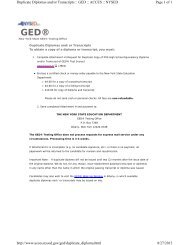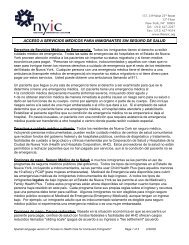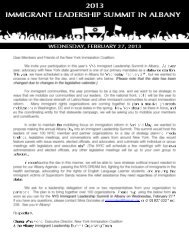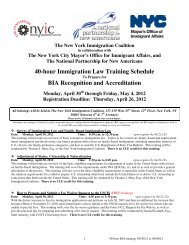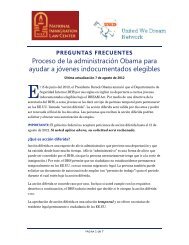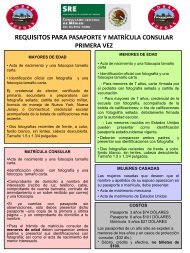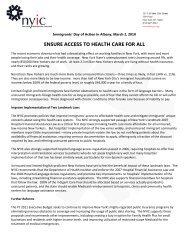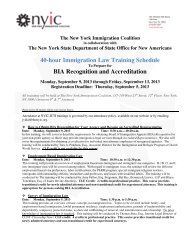Major Legislative Milestones in US Immigration History - New York ...
Major Legislative Milestones in US Immigration History - New York ...
Major Legislative Milestones in US Immigration History - New York ...
Create successful ePaper yourself
Turn your PDF publications into a flip-book with our unique Google optimized e-Paper software.
medical exam and needed care. Payment would occur either by redeem<strong>in</strong>g acoupon or through a pre-paid cl<strong>in</strong>ic card provided to participants <strong>in</strong> an immigrationreform program.The medical fees would be determ<strong>in</strong>ed on a slid<strong>in</strong>g-scale basis, as is currentlythe case for any other low- or moderate-<strong>in</strong>come patient, and the providerwould draw down from the pre-paid assessment. If a participant required morecare dur<strong>in</strong>g the period than the pre-paid assessment covered, he or she couldthen pay the provider’s prevail<strong>in</strong>g slid<strong>in</strong>g-scale charges out of pocket, like anyoneelse. If, at the end of the year, the participant had not utilized care <strong>in</strong> theamount of the pre-paid assessment, the rema<strong>in</strong>der could revert to the safety netprovider or be rolled over <strong>in</strong>to a future period.Pre-paid medical care would not constitute <strong>in</strong>surance coverage; <strong>in</strong>stead itwould establish a f<strong>in</strong>ancial relationship directly between the patient and thehealth provider. Under this option, the <strong>in</strong>dividual would be asked to pay aslid<strong>in</strong>g-scale rate to the health provider for any medical care used <strong>in</strong> excessof the pre-paid amount. This option would allow decisions about what medicalcare was needed to be made by health care providers, rather than bymanaged care adm<strong>in</strong>istrators, whose profit motives and duties to shareholderscan be at odds with the fundamental aim of provid<strong>in</strong>g appropriate medicalcare to patients.In addition to the advantages and concerns set out under Option Two, “SafetyNet Medical Home,” this option would require mak<strong>in</strong>g direct transfers ofemployee and employer assessments to medical providers, which would <strong>in</strong>volveadditional adm<strong>in</strong>istrative complexity.Option Four: <strong>New</strong>ly Created Insurance ProgramWith government assistance, small bus<strong>in</strong>esses and other employers that do notcurrently provide employee health benefits could jo<strong>in</strong> together to form newlycreated health <strong>in</strong>surance programs for pooled employees. Participants <strong>in</strong> animmigration reform program could be encouraged or required to enroll, andgroup-rated premiums would be paid by assessments or contributions fromemployees and employers. These new <strong>in</strong>surance products could also be openedup to other un<strong>in</strong>sured <strong>US</strong> residents, <strong>in</strong>clud<strong>in</strong>g workers who are classified byemployers as temporary, cont<strong>in</strong>gent, or part-time employees, who do not receiveprevail<strong>in</strong>g benefits, and who cannot afford to pay out-of-pocket for healthcare.<strong>New</strong> <strong>York</strong> State offers small employers, sole proprietors, and un<strong>in</strong>sured work<strong>in</strong>g<strong>in</strong>dividuals the opportunity to purchase health <strong>in</strong>surance coverage throughA ppendix II 177



